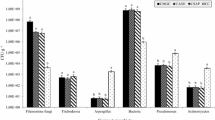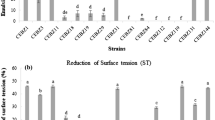Abstract
In situ and in vitro experiments were carried out to determine the effect of various composts (leafy fruit compost (LFC), garden compost (GC), and crops compost (CC)) and their water extract on Pythium debaryanum, Fusarium oxysporum f.sp. lycopersici, Sclerotium bataticola. Compost water extract (CWE) of LFC, GC, and CC were found to contain Bacillus spp., Micrococcus spp., Staphylococcus spp. and Corynebacterium spp., and the fungi Aspergillus spp., Rhizopus spp., and Drechslera spp., and various Actinomycetes. In situ results indicated considerable decrease in fungal growth around the unautoclaved compost especially in the case of S. bataticola and F. oxysporum f.sp. lycopersici, compared to the autoclaved compost. In vitro tests showed that concentration of CWE at 5, 10 and 15% (v/v) suppressed the hyphal growth of S. bataticola by 83% using 5% CC and by 94.4% using 5% LFC or 10% GC, and F. oxysporum f.sp. lycopersici by 94.4% using either composts. CWE of GC decreased fungal dry weight of F. oxysporum f.sp. lycopersici by 97.7%, P. debaryanum by 92.8%, and S. bataticola by 84.4%; CC decreased F. oxysporum f.sp. lycopersici by 94%, P. debaryanum by 86.2%, and S. bataticola by 63.3%, while CWE of LFC was the least effective against the tested fungi. CWE produced clear inhibition zones against all the tested fungi. Microflora found in CWE have an important role in suppressing the growth of tested fungi. CWE contained neither antibiotics nor siderophores. The presence of protease, chitinase, lipase and β-1,3 glucanase (lysogenic enzymes) in CWE indicates a possible role in fungal degradation.
Similar content being viewed by others
References
Alexopoulos, C.J., Mims, C.W. & Blackwell, M. 1995 Introductory Mycology. 4th edn., New York & London: John Wiley & Sons, Inc. ISBN 0-471.
Baziramakenga, R. & Simard, R.R. 1998 Low molecular weight aliphatic acid contents of composted manures. Journal of Environmental Quality 27, 557–561.
Biddlestone, A.J. & Gray, K.R. 1985 Composting. In Comprehensive Biotechnology, eds. Robinson, C.W. & Howell, J.A. vol. 4, pp. 1059–1070. Oxford & New York: Pergamon Press. ISBN 0-08032512-2.
Boehm, M.M., Madden, L.V. & Hoitink, H.A.J. 1993 Effect of organic matter decomposition level on bacterial species diversity and composition in relationship to Pythium damping-off severity. Applied and Environmental Microbiology 59, 4147–4179.
Boulter, J.I., Boland, G.J. & Trevors, J.T. 2000 Compost: a study of the development process and end product potential for suppression of turfgrass disease. World Journal of Microbiology and Biotechnology 16, 115–134.
Chernin, L., Ismailov, Z., Haran, S. & Chet, I. 1995 Chitinolytic Enterobacter agglomerans antagonistic to fungal plant pathogens. Applied and Environmental Microbiology 61, 1720–1726.
Cronin, M.J., Yohalem, D.S., Harris, R.F. & Andrews, J.H. 1996 Putative mechanism and dynamics of inhibition of the apple scab pathogen Venturia inaequalis by compost extracts. Soil Biology and Biochemistry 28, 1241–1249.
Deborah, R.F. 1988 Role of antibiosis in the biocontrol of plant diseases. Annual Review of Phytopathology 26, 75–91.
De Brito Alavarez, M.A., Gagne, S. & Antoun, H. 1995 Effect of compost on rhizosphere micro flora of the tomato and on the incidence of plant growth-promoting rhizobacteria. Applied and Environmental Microbiology 61, 194–199.
Elad, Y. & Shtienberg, D. 1994 Effect of compost water extracts on grey mould Botrytis cinerea. Crop Protection 13, 109–114.
Elad, Y., Chet, I. & Henis, Y. 1982 Degradation of plant pathogenic fungi by Trichoderma harzianum. Canadian Journal of Microbiology 28, 719–725.
Hankin, L. & Anagnostakis, S.L. 1975 The use of solid media for detection of enzyme production by fungi. Mycologia 67, 597–607.
Haran, S., Schickler, A., Oppenheim, A. & Chet, I. 1996 Differential expression of Trichoderma harzianum chitinase during mycoparasitism. Phytopathology 86, 980–985.
Hardy, G.E.J. & Sivasithamparam, K. 1991 Sporangial responses do not reflect microbial suppression of Phytophthora drechsleri in composted eucalyptus bark mix. Soil Biology and Biochemistry 23, 756–765.
Harman, G.E., Hayes, C.K., Lorito, M., Broadway, R.M., Dipietro, A., Peterbauer, C. & Tronsmo, A. 1993 Chitinolytic enzymes of Trichoderma harzianum: purification of chitobiosidase and endochitinase. Phytopathology 83, 313–318.
Hoitink, H.A.J. & Fahy, P.C. 1986 Basis for the control of soil born plant pathogens with composts. Annual Review of Phytopathology 24, 93–114.
Hoitink, H.A.J. & Grebus, M.E. 1994 Status of biological control of plant disease with composts. Compost Science and Utilization 2, 6–12.
Inbar, J. & Chet, I. 1995 The role of recognition in the induction of specific chitinases during mycoporasitism. Microbiology 141, 2823–2829.
Kai, H., Ueda, T. & Sakaguchi, M. 1990 Antimicrobial activity of bark compost extracts. Soil Biology and Biochemistry 22, 983–986.
Leong, J. 1986 Siderophores: their biochemistry and possible role in the biocontrol of plant pathogens. Annual Review of Phytopathology 24, 187–209.
Logsdon, G. 1990 Plant protection through compost. BioCycle 31, 52–54.
Loper, J.E. 1988 Role of fluorescent siderophore production in biological control of Pythium ultimum by a Pseudomanas fluorescens strain. Phytopathology 78, 166–172.
Liu, L., Kloepper, J.W. & Tuzun, S. 1995 Induction of systemic resistance in cucumber by plant growth-promoting rhizobateria: duration of protection and effect of host resistance on protection and root colonization. Phytopathology 85, 1064–1068.
Madi, L., Katan, T., Katan, J. & Henis, Y. 1997 Biological control of Sclerotium rolfsii and Verticillium dahliae by Talaromyces flavus is mediated by different mechanisms. Phytopathology 87, 1054–1060.
McQuilken, M.P., Whipps, J.M. & Lynch, J.M. 1994 Effects of water extracts of a composted manure-straw mixture on the plant pathogen Botrytis cinerea. World Journal of Microbiology and Biotechnology 10, 20–26.
Polavarapu, S. 2000 Evaluation of phytotoxicity of diazinon and captan formulations on highbush blueberries. Horttechnology 10, 308–315.
Popkin, R. 1995 Good news for waste watchers: recycling, composting show results for the future. Environmental Protection Agency Journal 21, 18–19.
Park, S.K., Lee, H.Y. & Kim, K.C. 1995 Role of chitinase produced by Chromobacterium violaceum in the suppression of Rhizoctonia damping-off. Korean Journal of Plant Pathology 11, 304–311.
Phae, C.G., Sasaki, M., Shoda, M. & Kubota, H. 1990 Characteristics of Bacillu subtilis isolated from composts suppressing phytopathogenic microorganisms. Soil Science and Plant Nutrition 36, 575–586.
Raaijmakers, J.M., Leeman, M.M., Van Oorschot, M.M.P., Van Dersluis, I., Schippers, B. & Bakker, P.A.H.M. 1995 Dose response relationships in biological control of Fusarium wilt of radish by Pseudomonas spp. Phytopathology 85, 1075–1081.
Ridout, C.J., Coley-Smith, J.R. & Lynch, J.M. 1988 Fractionation of extracellular enzymes from mycoparasitic strain of Trichoderma harzianum. Enzyme and Microbial Technology 10, 180–187.
Shen, D. 2000 Beneficial microorganisms and metabolites derived from agriculture wastes in improving plant health and protection. Journal of Crop Protection 3, 349–366.
Sierra, G. 1957 A simple method for the detection of lipolytic activity of microorganisms and some observations on the influence of the contact between cells and fatty substrates. Antonie van Leeuwenhoek 23, 15–22.
Scher, F.M. & Baker, R. 1982 Effect of Pseudomonas putida and a synthetic iron chelator on induction of soil suppressiveness to Fusarium wilt pathogens. Phytopathology 72, 1567–1573.
Schisler, D.A., Slininger, P.J. & Bothast, R.J. 1997 Effects of antagonist cell concentration and two-strain mixtures on biological control of Fusarium dry rot of potatoes. Phytopathology 87, 177–183.
Singh, P.P., Shin, Y.C., Park, C.S. & Chung, Y.R. 1999 Biological control of Fusarium wilt of cucumber by chitinolytic bacteria. Phytopathology 89, 92–99.
Sneath, P.H.A., Mair, N.S. & Sharpe, M.E. 1986 Bergey's Manual of Systematic Bacteriology, vol. 2. London: Williams and Wilkins ISBN 0683078933.
Staley, J.T., Bryant, M.P., Pfennig, N. & Holt, J.G. 1989 Bergey's Manual of Systematic Bacteriology,vol. 3. London: Williams and Wilkins ISBN 0683079085.
Takaya, N., Yamazaki, D., Horiuchi, H., Ohta, A. & Takagi, M. 1998 Intracellular chitinase gene from Rhizopus oligosporus: molecular cloning and characterization. Microbiology 144, 2647–2654.
Theodore, M. & Toribio, J.A. 1995 Suppression of Pythium apharidermatum in composts prepared from sugar cane factory residues. Plant and Soil 177, 219–223.
Tuitert, G., Szczech, M. & Bollen, G.J. 1998 Suppression of Rhizoctonia solani in potting mixtures amended with compost made from organic household waste. Phytopathology 88, 764–772.
Van Peer, R., Niemann, G.J. & Schippers, B. 1991 Induced resistance and phytoalexin accumulation in biological control of Fusarium wilt of carnation by Pseudomonas sp. strain WCS 417r. Phytopathology 81, 728–734.
Watanabe, K. & Hayano, K. 1995 Seasonal variation of soil protease activities and their relation to proteolytic bacteria and Bacillus spp. in paddy field soil. Soil Biology and Biochemistry 27, 197–203.
Wei, G., Kloepper, H.W. & Tuzun, S. 1991 Induction of systemic resistance of cucumber to Colletotirchum orbiculare by selected strains of plant growth-promoting rhizobacteria. Phytopathology 81, 1508–1512.
Williams, S.T., Sharpe, M.E. & Holt, J.G. 1989 Bergey 's Manual of Systematic Bacteriology, vol. 4. London: Williams and Wilkins. ISBN 0683090615.
Workneh, F. & Van Bruggen, A.H.C. 1994 Microbial density, composition, and diversity in organically and conventionally managed rhizosphere soil in relation to suppression of corky root of tomatoes. Applied Soil Ecology 1, 219–230.
Yohalem, D.S., Harris, R.F. & Andrews, J.H. 1994 Aqueous extracts of spent mushroom substrate for foliar disease control. Compost Science and Utilization 2, 67–74.
Yohalem, D.S., Nordheim, E.V. & Andrews, J.H. 1996 The effect of water extracts of spent mushroom compost on apple scabe in the field. Phytopathology 86, 914–922.
Zhang, W., Han, D.Y., Dick, W.A., Davis, K.R. & Hoitink, H.A.J. 1998 Compost and compost water extract-induced systemic acquired resistance in cucumber and arabidopsis. Phytopathology 88, 450–454.
Author information
Authors and Affiliations
Rights and permissions
About this article
Cite this article
El-Masry, M., Khalil, A., Hassouna, M. et al. In situ and in vitro suppressive effect of agricultural composts and their water extracts on some phytopathogenic fungi. World Journal of Microbiology and Biotechnology 18, 551–558 (2002). https://doi.org/10.1023/A:1016302729218
Issue Date:
DOI: https://doi.org/10.1023/A:1016302729218




